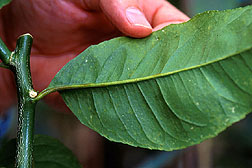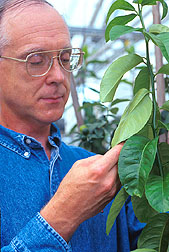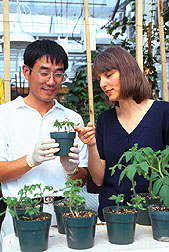VIROIDS!—From Scourge to Boon in the 21st Century?
|
|
Like some viruses, viroids are little more than a strand of genetic material called ribonucleic acid (RNA). Unlike most viral RNAs, viroids can't make proteins, nor do they wear a protective protein shell to avoid being torn apart by a host plant's powerful enzymes.
So how do these naked RNA pathogens still manage to cause disease in susceptible plants and crops like potatoes, tomatoes, and certain fruit trees?
"They must possess some characteristic that allows them to masquerade as a normal component of the host cell," muses Robert Owens, a chemist at ARS' Molecular Plant Pathology Laboratory in Beltsville, Maryland.
There, along with ARS plant pathologist Rosemarie Hammond and other colleagues, Owens is conducting basic research with threefold intent:
- to use viroids as probes to learn how plant proteins and nucleic acids move in and out of cell nuclei;
- to accomplish what conventional breeding has not: produce crop plants that withstand viroid diseases; and
- to harness the beneficial effects of viroid infection for agricultural applications, like dwarfing citrus trees.
|
|
Owens says the work complements earlier studies that resulted in a widely used dot-blot test for detecting viroids (see "Tracking the Elusive Viroid," Agricultural Research, May 1989, p. 4). Currently, Owens, Hammond, and Oklahoma State University colleague Biao Ding are running experiments to identify the molecular pathways by which viroids move from cell to cell and cross the cytoplasm that surrounds the cells' nuclei. For it's there that most viroids replicate and—depending on the host plant—trigger a biochemical chain of events that leads to disease symptoms, like stunted growth.
Hunting the viroid in its natural habitat, the nucleus, requires an array of high-tech tools, including DNA cloning, fluorescent labeling, microinjection, and viral vectors.
At the heart of all this activity is the potato spindle tuber viroid (PSTVd), which the scientists use in their experiments. The 1971 discovery of PSTVd by ARS plant pathologist Theodor O. Diener, now retired, was a major breakthrough in 20th century biological research.
Hammond's experiments with PSTVd today include searching for targeting signals that the pathogen uses to hitch a ride into the nuclei of tomato and tobacco plant cells.
Unlike plant viruses, the viroid doesn't produce a specialized movement protein. Movement proteins help viruses move from cell to cell as well as long distances through the plant's phloem, or nutrient transport system.
Without movement proteins, or viruses on which to hitchhike, how then does the viroid still get into the nucleus? "There's something that pulls the viroid into the nucleus and escorts it back out," says Robert E. Davis, who leads the lab where Hammond and Owens work.
"We know the viroid doesn't make any proteins itself," Davis adds, "so it's from the plant—something it's capable of making itself."
To find that something, Hammond and colleague Yan Zhao designed an experiment in which a potato virus shuttles the viroid into the cytoplasm. The viroid is embedded in a reporter gene that encodes green fluorescent protein, a fluorescent marker. Another piece of RNA, called an intron, blocks translation of messenger RNA for the protein while in the cytoplasm.
This enables scientists to monitor the viroid's movement into the nucleus. Once there, the intron is excised, and the functional mRNA for the protein can return to the cytoplasm.
Hammond says the plan is to repeat the experiment, each time removing more of the viroid's 359 nucleotides. Eventually they hope to pare it down to its barest essentials—namely the specific set of signals involved in targeting viroid RNAs into the nucleus.
Also of interest is determining whether certain cellular components are involved in the onset of viroid disease symptoms.
Experiments with transgenic tomatoes, for example, may reveal whether stunted growth is a reaction of certain signaling proteins called protein kinases (PK) to viroid infection.
By reducing expression of the plant's PK-making genes with antisense techniques, "what we find is less stunting upon viroid infection, which may give some evidence that protein kinases may be involved," Hammond reports.
The scientists hope their experiments will set the stage for genetically engineering plants that make a molecule to block the viroid's access to the nucleus. In theory, the viroid should then be unable to replicate and spread. "You don't necessarily have to produce total immunity to viroid infection," says Owens. "Simply blocking long-distance movement would be enough to localize infection."
Whether hindering the viroid or harnessing it for citrus dwarfing, Davis says the key question to answer is: "What part of the viroid molecule is responsible?"—By Jan Suszkiw, Agricultural Research Service Information Staff.
This research is part of Plant Diseases, an ARS National Program (#303) described on the World Wide Web at http://www.nps.ars.usda.gov/programs/cppvs.htm.
Robert E. Davis, Rosemarie Hammond, Robert A. Owens, and Yan Zhao are at the USDA-ARS Molecular Plant Pathology Laboratory, 10300 Baltimore Ave., Bldg. 011A, Room 252, Beltsville, MD 20705; phone (301) 504-5745, fax (301) 504-5449.
"VIROIDS!—From Scourge to Boon in the 21st Century?" was published in the December 1999 issue of Agricultural Research magazine.









